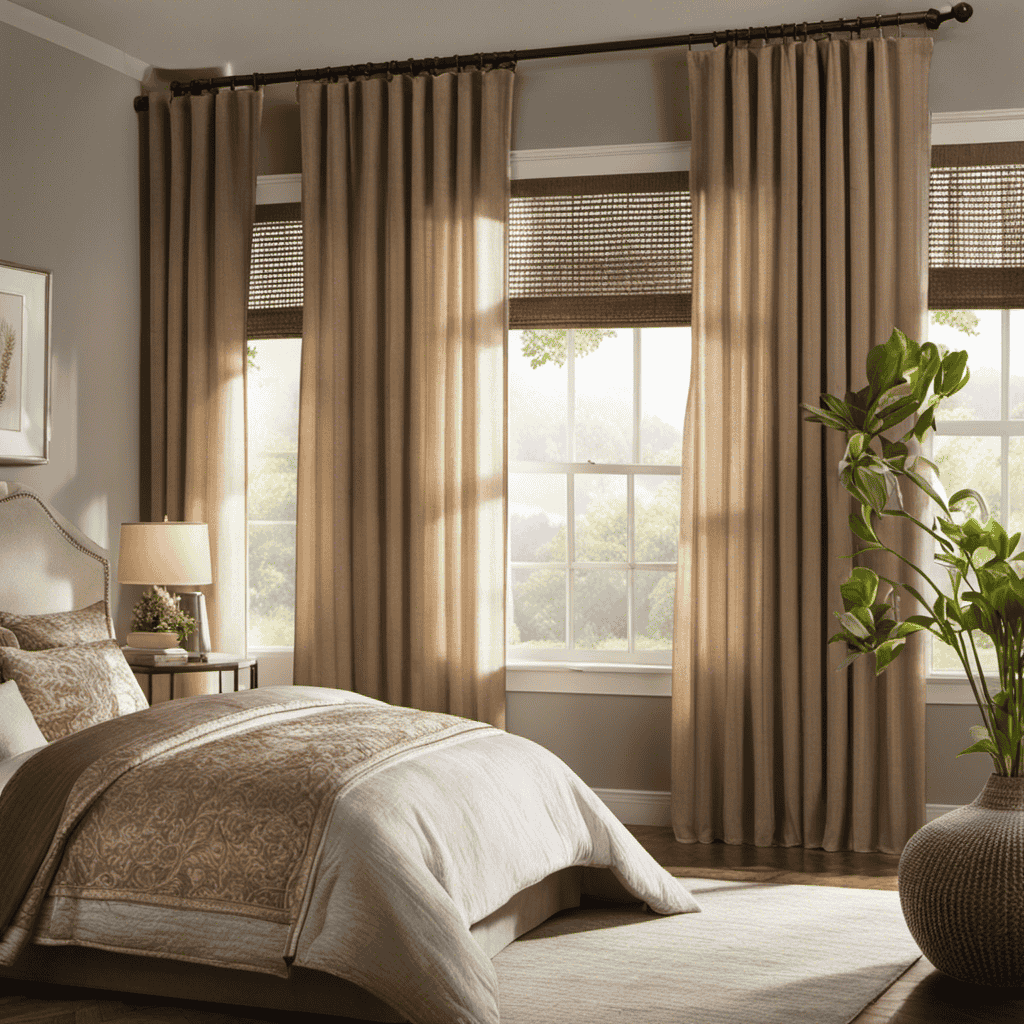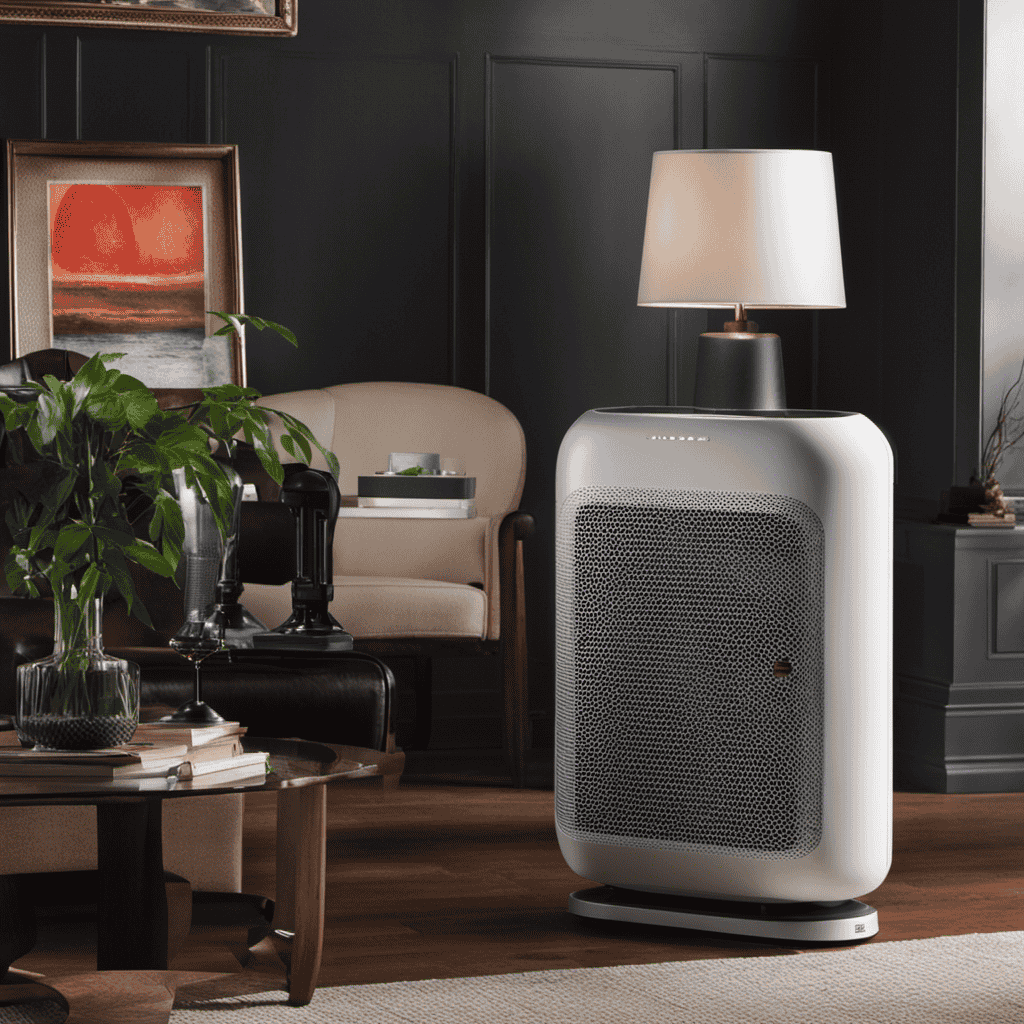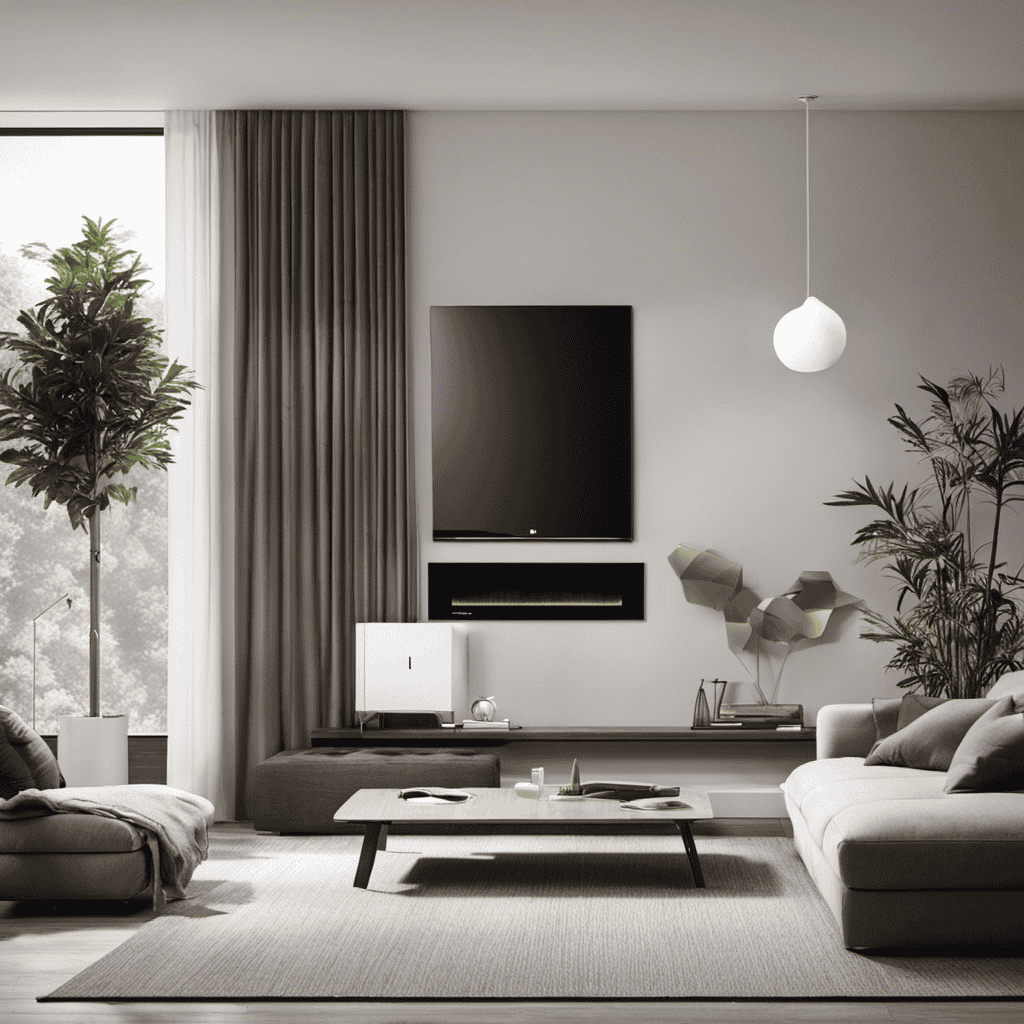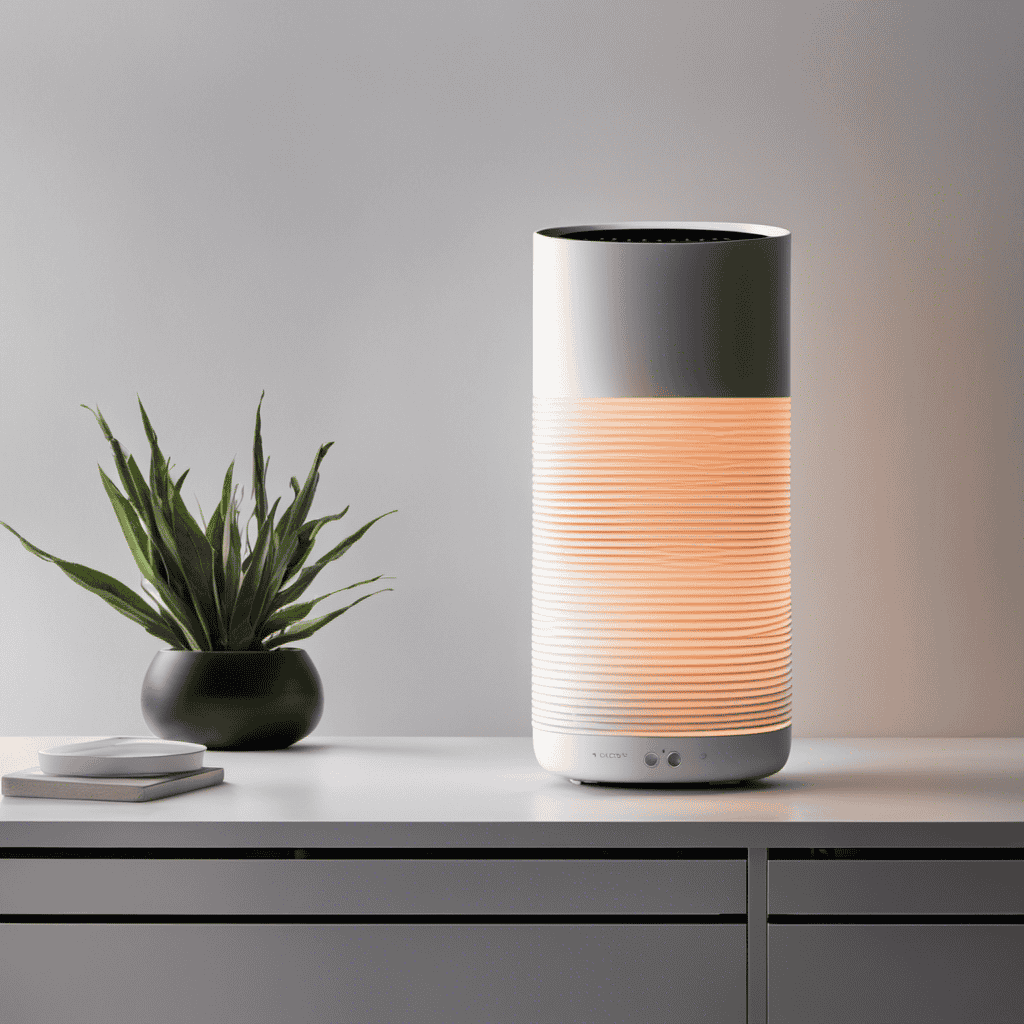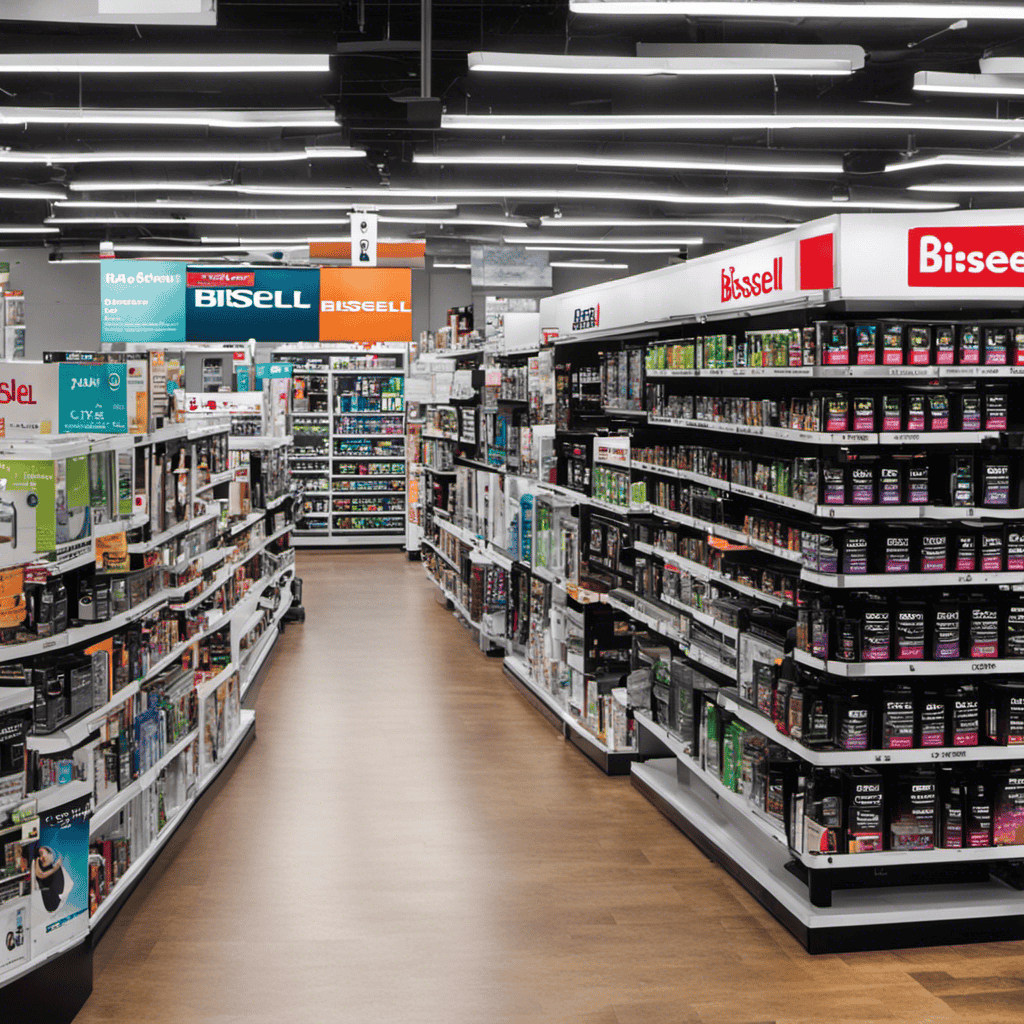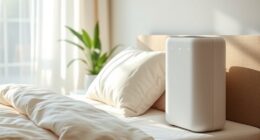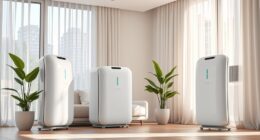As someone who specializes in environmental health, I am here to address the important question: Who should consider using an air purifier?
In today’s polluted world, it is essential to prioritize our well-being. Air purifiers offer a powerful solution, providing a breath of fresh, clean air.
From allergies to asthma, pet owners to smokers, and those living in polluted environments, air purifiers can make a significant difference.
Join me as we delve into the health benefits and explore why investing in an air purifier is a wise choice for all.
Key Takeaways
- Air purifiers can benefit individuals with allergies and asthma by reducing symptoms and improving respiratory health.
- They effectively filter out pollutants and allergens from the air, including dust, pollen, pet dander, and airborne viruses.
- Air purifiers should be used in conjunction with other preventive measures such as proper ventilation, regular cleaning, and avoidance of triggers for optimal results.
- Children, especially those with developing respiratory systems, can greatly benefit from the use of air purifiers to maintain clean and healthy indoor air.
Health Benefits of Air Purifiers
Air purifiers can help reduce allergies and asthma symptoms. Research has shown that these devices are effective in improving respiratory health by filtering out pollutants and allergens from the air. Particulate matter, such as dust, pollen, and pet dander, can trigger allergies and worsen asthma symptoms.
Air purifiers with high-efficiency particulate air (HEPA) filters can capture these particles, reducing their presence in the indoor environment. Additionally, air purifiers can remove volatile organic compounds (VOCs) and other harmful chemicals that can have adverse health effects.
These devices can be particularly beneficial for individuals with respiratory conditions, such as asthma, as they can provide cleaner air and reduce the triggers that may exacerbate symptoms. However, it is important to note that air purifiers are not a cure-all solution and should be used in conjunction with proper ventilation and other preventive measures to maintain optimal respiratory health.
Allergies and Air Purifiers
Using an air purifier can greatly alleviate allergy symptoms. Research has shown that air purifiers can effectively remove allergens such as pollen, dust mites, and pet dander from the air, reducing exposure and subsequently reducing symptoms in individuals with allergies. This is particularly important for children, as their developing respiratory systems are more susceptible to the harmful effects of allergens.
As an environmental health specialist, I have extensively studied the effects of air purifiers on respiratory illnesses, especially in children. Furthermore, studies have also indicated that air purifiers can help prevent respiratory illnesses by capturing airborne viruses and bacteria.
However, it is important to note that air purifiers should not be solely relied upon as the sole solution for allergies and respiratory illnesses. Other preventive measures such as maintaining clean indoor environments and practicing good hygiene should also be followed to ensure optimal respiratory health.
Asthma and Air Purifiers
As an environmental health specialist, I would like to discuss the effectiveness of air purifiers for asthma. Scientific research has shown that air purifiers can be beneficial for individuals with asthma by reducing the presence of airborne allergens and pollutants that can trigger asthma symptoms.
The benefits of clean air are also worth considering. Clean air is crucial for overall health and well-being, as it can reduce the risk of respiratory diseases and improve lung function.
However, it is important to note that the effectiveness of air purifiers may vary depending on factors such as the type of pollutants present and the size of the space being treated. Therefore, individuals with asthma should consider consulting with a healthcare professional to determine the most suitable air purifier for their specific needs.
Purifier Effectiveness for Asthma
If you have asthma, an air purifier can greatly reduce the triggers that worsen your symptoms. Research has shown that air purifiers can be effective in improving indoor air quality and reducing respiratory symptoms in individuals with asthma.
Air purifiers work by filtering out harmful particles and allergens from the air, such as dust mites, pet dander, pollen, and mold spores. This helps to create a cleaner and healthier indoor environment, which is especially beneficial for children with asthma who are more susceptible to respiratory conditions.
Studies have found that using air purifiers in homes with asthma patients can lead to a decrease in asthma symptoms, including wheezing, coughing, and shortness of breath. However, it is important to note that air purifiers should be used in conjunction with other preventive measures, such as regular cleaning, proper ventilation, and avoidance of triggers, for optimal results.
Benefits of Clean Air
To improve your overall well-being, it’s important to breathe in clean air that is free from pollutants and allergens. Air pollution effects are well-documented and can have serious impacts on our health. Indoor air quality is particularly important, as we spend a significant amount of time indoors.
Indoor air can be contaminated with various pollutants, such as volatile organic compounds (VOCs), tobacco smoke, and particulate matter. Exposure to these pollutants can lead to respiratory issues, allergies, and even cardiovascular problems. Therefore, it is crucial to take measures to improve indoor air quality, such as proper ventilation, regular cleaning, and the use of air purifiers.
Air purifiers are designed to filter out harmful pollutants and allergens, providing cleaner and healthier air to breathe. Transitioning to the next section, let’s now explore the impact of allergens on air quality.
Allergens and Air Quality
Allergens in the air can cause respiratory issues and allergies, making it important to address indoor air quality. Airborne pollutants, such as pollen, dust mites, and pet dander, can trigger allergic reactions and worsen the symptoms of respiratory conditions like asthma. To better understand the impact of these allergens on air quality, let’s examine some common air pollutant sources in a table:
| Air Pollutant Source | Examples |
|---|---|
| Outdoor Sources | Vehicle emissions, industrial pollution |
| Indoor Sources | Tobacco smoke, cooking fumes, cleaning products |
| Biological Sources | Mold, pollen, pet dander |
Air Purifiers for Pet Owners
As an environmental health specialist, I am often asked about effective methods for controlling pet dander, eliminating odors, and reducing allergens in homes.
Pet dander, which includes microscopic particles of skin, saliva, and urine, can trigger allergic reactions in sensitive individuals. To address this issue, it is important to implement strategies such as regular cleaning, using HEPA filters, and keeping pets out of certain areas of the home.
Additionally, odor elimination techniques, such as proper ventilation and the use of air purifiers with activated carbon filters, can help remove unpleasant smells associated with pets.
Lastly, implementing allergen reduction methods, such as frequent vacuuming, washing bedding in hot water, and minimizing the use of upholstered furniture, can significantly reduce allergens and improve indoor air quality for both pet owners and those with allergies.
Pet Dander Control
If you’re a pet owner, you’ll want an air purifier to control pet dander. Pet dander consists of tiny flecks of skin shed by animals, which can trigger allergies and asthma in sensitive individuals. An air purifier with a HEPA (High-Efficiency Particulate Air) filter is the most effective at capturing pet dander and other airborne allergens. It can remove up to 99.97% of particles as small as 0.3 microns in size. Additionally, some air purifiers come with activated carbon filters, which can help eliminate odors associated with pets. To help you choose the right air purifier for pet dander control, here is a comparison table:
| Air Purifier | Features | Price |
|---|---|---|
| Model A | HEPA filter, activated carbon filter | $150 |
| Model B | HEPA filter, ionizer, UV-C light | $200 |
| Model C | HEPA filter, smart sensor technology | $250 |
Odor Elimination Techniques
To eliminate odors, you should consider using activated carbon filters in your air purifier. These filters are designed to trap and remove odorous compounds from the air, resulting in cleaner and fresher indoor environments. Activated carbon works by adsorbing the odor-causing molecules onto its porous surface, effectively removing them from the air.
Here are some reasons why activated carbon filters are effective in eliminating odors:
- High adsorption capacity: Activated carbon has a large surface area, allowing it to adsorb a significant amount of odor-causing molecules.
- Versatility: Activated carbon filters can effectively remove a wide range of odors, including those from pets, smoke, cooking, and chemicals.
- Long-lasting effectiveness: Activated carbon filters can remain effective for an extended period, depending on the quality and maintenance of the filter.
When it comes to odors in your home, relying on air fresheners or home remedies may provide temporary relief, but they do not address the underlying issue. Using activated carbon filters in your air purifier is a scientifically proven method that provides a long-term solution to eliminate odors and improve indoor air quality.
Allergen Reduction Methods
Activated carbon filters can also help reduce allergens in your home, trapping and removing particles like dust, pollen, and pet dander from the air. These filters are designed to adsorb and neutralize these allergens, improving indoor air quality and reducing the risk of allergies and respiratory issues.
However, it’s important to note that the effectiveness of activated carbon filters may vary depending on factors such as the size of the filter, the airflow rate, and the type and concentration of allergens in the environment.
In addition to using activated carbon filters, regular air purifier maintenance is crucial to ensure optimal performance. This includes cleaning or replacing filters, cleaning the unit itself, and regularly monitoring the air quality in your home. Different types of air purifiers may have different maintenance requirements, so it’s important to refer to the manufacturer’s instructions for proper care and maintenance.
Air Purifiers for Smokers
Smokers can benefit from using air purifiers to help improve air quality in their homes. As an environmental health specialist, I have found that air purifiers can effectively reduce the harmful effects of secondhand smoke and improve the overall air quality for both smokers and non-smokers.
Here are some key benefits of using air purifiers for smokers:
- Reduction of smoke particles and odors: Air purifiers can capture and remove smoke particles, reducing the presence of harmful chemicals and odors in the air.
- Improved respiratory health: Clean air can help alleviate respiratory symptoms and reduce the risk of respiratory diseases associated with cigarette smoke.
- Enhanced indoor environment: Air purifiers can create a cleaner and healthier indoor environment, making it more comfortable for everyone.
By using air purifiers, smokers can significantly improve the air quality in their homes, benefiting not only themselves but also their loved ones.
Transitioning to the next section on ‘air purifiers for polluted environments,’ it is important to understand that these devices can also be beneficial for individuals living in areas with polluted outdoor air.
Air Purifiers for Polluted Environments
After discussing the importance of air purifiers for smokers in the previous subtopic, let’s now shift our focus to the use of air purifiers in polluted environments, such as cars and offices.
As an environmental health specialist, I want to emphasize the significance of clean air in these settings, considering the potential risks associated with exposure to pollutants.
In cars, air purifiers can help reduce the levels of harmful particles and pollutants present inside the vehicle. These devices utilize filters to capture and remove airborne contaminants, improving the overall air quality and reducing the risk of respiratory issues for both drivers and passengers.
Similarly, in offices where indoor air pollution can be a concern, air purifiers can play a vital role in creating a healthier work environment. They can help remove allergens, dust, mold spores, and volatile organic compounds (VOCs), which can have negative effects on employee health and productivity.
However, it is important to note that while air purifiers can be beneficial, they should be used in conjunction with other preventive measures, such as proper ventilation and regular cleaning, to achieve optimal air quality. Additionally, selecting the right type and size of air purifier is crucial for maximum efficiency and effectiveness.
Frequently Asked Questions
How Often Should I Replace the Filters in My Air Purifier?
I should replace the filters in my air purifier every 3 to 6 months, depending on the usage and air quality. It’s important to choose air purifiers from reputable brands known for their effective filtration systems.
Can Air Purifiers Help With Household Odors?
Air purifiers can help eliminate household odors by filtering out contaminants and pollutants. There are various types of air purifiers available, each with their own benefits. It is important to choose one that suits your specific needs.
Are There Any Potential Side Effects or Risks Associated With Using an Air Purifier?
There may be potential benefits of using an air purifier, but it is important to consider the long-term effects. It is crucial to weigh the potential risks and benefits before deciding if an air purifier is necessary.
Can Air Purifiers Remove Harmful Gases and Chemicals From the Air?
Air purifiers have been proven to effectively remove harmful gases and chemicals from the air, providing numerous benefits for those with allergies. They are a valuable tool in removing allergens and pollutants, improving indoor air quality.
Do Air Purifiers Use a Lot of Electricity?
Air purifiers have varying levels of energy consumption, depending on the model and usage. It’s important to consider the cost efficiency and potential long-term savings when choosing an air purifier.
Do I Really Need an Air Purifier for My Home?
If you’re considering adding an air purifier to your home, keep these important air purifier buying tips in mind. Consider the size of your space, the types of pollutants you want to eliminate, and your budget. Research different models to find the best fit for your needs.
Conclusion
In conclusion, air purifiers can be beneficial for various individuals and environments. They have been proven to improve air quality and reduce allergens, making them particularly useful for those with allergies or asthma. Additionally, air purifiers can help pet owners by eliminating pet dander and odors. Smokers can also benefit from air purifiers as they can remove harmful particles from the air.
Lastly, in polluted environments, air purifiers can play a crucial role in reducing the health risks associated with poor air quality. Overall, air purifiers provide a valuable tool for improving public health and well-being, creating cleaner and safer environments for everyone.
With their ability to remove pollutants and improve air quality, air purifiers are a game-changer in the field of environmental health. They act as a shield, protecting us from the invisible enemies that lurk in the air, ensuring that the air we breathe is as pure and fresh as the morning dew on a pristine meadow.
Embracing the power of air purifiers is a step towards a healthier and happier future.
